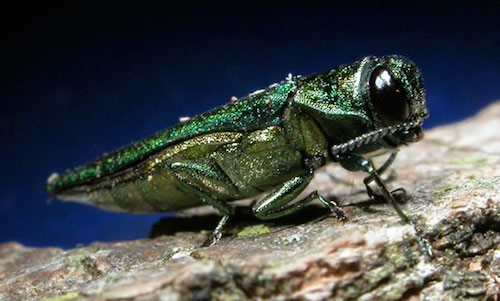Dealing with the Emerald Ash Borer
The emerald ash borer beetle strikes fear in the hearts of tree lovers everywhere, and for good reason. Since its discovery near Detroit in 2002, the tiny green emerald ash borer beetle has decimated the ash tree population in several states and Canada. What, if anything, can be done to slow or stop the spread of this terrible invasive insect?
Emerald Ash Borer: Tiny Trouble
The emerald ash borer beetle probably found its way here from its native Asia in wooden shipping pallets or other wooden packing materials. However it got here, it is here, and it's been causing trouble ever since.
The adult emerald ash borer beetle itself causes little damage other than some cosmetic damage to ash trees as it eats the leaves. The real culprit to ash tree decline is the emerald ash borer (EAB) larvae. The EAB larvae live and grow just under an ash tree's bark, which they consume in massive quantities.
When the inner ash tree bark is eaten, the tree loses its ability to transport water and nutrients from the root structure up through the tree to its branches and leaves. Thus crippled, the tree slowly dies. And thanks to this emerald ash borer invasion, ash trees are dying off by the millions.
Emerald Ash Borer Establishments
It's really not hard to tell where emerald ash borer has been established: the ash trees are dead or dying. Almost all of them. It's alarming to drive through these decimated zones and see these beautiful, hearty trees being slowly choked to death by these tiny green beetles.
The emerald ash borer's territory continues to expand. Since discover in 2002 in southeastern Michigan, it has rapidly moved to new areas: Ontario and Ohio in 2003, Indiana in 2004, Illinios and Maryland in 2006, Pennsylvania and West Virginia in 2007, Wisconsin, Virginia, and Missouri in 2008, Kentucky, New York and Minnesota in 2009, Iowa and Tennessee in 2010, Kansas, Massachusetts and Connecticut in 2012, New Hampshire, North Carolina and Georgia in 2013. So far, quarantines and other steps have been unable to stop this rapid expansion.
The damage to ash trees caused by emerald ash borers is incredible. In Michigan alone, tens of millions of trees have been killed; overall, hundreds of millions of ash trees are at risk.
The Look and Life Cycle of the Emerald Ash Borer Beetle
An adult emerald ash borer beetle is very small (1/2 inch long, 1/8 inch wide) and is a dark metallic green.
Emerald ash borers have a 1 to 2 year life span. Adults emerge from ash trees in late May through June; females lay their eggs 2 weeks later. Once hatched, the EAB larvae bore through the bark into the tree, where they begin feeding on the inside of the bark. EAB larvae feed all summer, through October. They wait through the winter in the outer bark, then in the spring pupation begins and the cycle starts over.
The unsually intense winter of 2014 in the Midwest led many to hope that the brutal cold would slow or stop the emerald ash borer growth. While the cold may slow the spread down somewhat, overall the effect of the winter will be minimal.
Identifying Emerald Ash Borer in Ash Trees
Early EAB infestation is very difficult to see; only after the insects have caused large-scale damage to the tree does it become visible. The canopy of infested trees will begin to thin, typically towards the top of the tree at first, as the beetle damage begins to restrict the flow of water and nutrients up the tree. Up to one-third or half of a trees' canopy can be destroyed in just one season. Once thinning is observed, the tree is typically dead within two years. Some infested trees will sprout new branches at the bottom of the trunk at ground level; this is another clear indication of EAB damage, as the tree desperately tries to grow new branches and leaves below the infestation level.
When the adult beetles emerge from the ash tree in May and June, they make a D-shaped exit hole, about 1/8 inch wide, in the trunk.
Spread of the Emerald Ash Borer
Adult EAB beetles can fly up to half a mile from one ash tree to another. In areas with dense populations of ash trees, the beetles are able to infest large numbers of trees very easily. The most common form of EAB spread, however, is humans moving ash wood or nursery trees from an infested area to an uninfested area. Though municipalities have established quarantine zones to cut down on transporting the bugs, enforcement of these quarantines is next to impossible to enforce.
All Ash Trees are Vulnerable to Emerald Ash Borer
Emerald ash borer beetles typically infest ash trees that are already stressed or unhealthy, but even healthy ash trees are at risk. So far, in North America only ash trees appear to be affected by the emerald ash borer, but all species of the ash tree are vulnerable to infestation. In areas of heavy infestation, small ash trees are dead within two years; large trees are usually dead in 3 or 4 years. This is a true epidemic.







































































